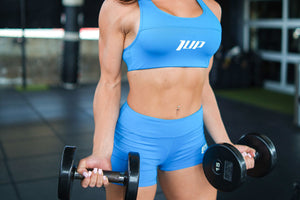The bench press is one of the bread and butter lifts for building strength and chiseling your chest, shoulders, and triceps. It’s also an exercise that causes shoulder pain for many athletes, both recreational and professional.
Today, we’ll discuss what causes shoulder pain when bench pressing and how to stop it once and for all.
What Causes Shoulder Pain When Bench Pressing?
When we think of the shoulder, we almost always think of the three deltoid muscles (anterior, middle, and posterior). And, while those are the three “main” muscles surrounding the shoulder, there is a whole supporting network of muscles and connective tissue that keep the shoulder healthy, stable, and functional.
The shoulder joint is a ball-and-socket type joint where the “ball” is the top of the humerus (upper arm bone) and the “socket) is the glenoid fossa, which is located on the edge of the shoulder blade (scapula).
Now, the “ball” of the ball-and-socket joint doesn’t fit directly into the “socket”. Instead, it sits on top of the socket, kept in place by the muscles of the rotator cuff.[1]
These tiny muscles that make up the rotator cuff are an area of considerable focus when it comes to preventing shoulder pain and/or injury.
However, the rotator cuff is only part of the reason you may be feeling shoulder pain when benching.
The other source of concern is the muscles of the scapula, or rather, the ones that help stabilize it.
During the bench press, you want the humerus to remain centralized inside the ball-and-socket, it shouldn’t be migrating up into the other structures of the shoulder joint.
If the muscles that stabilize and retract the scapula are weak, as you go to lower the bar to your chest, your scapula rotates upward, and your shoulders go into internal rotation -- leading to irritation, pain, and increased risk of injury.
Finally, allowing your elbows to flare out too much when bench pressing can also be a source of pain during bench pressing.
Again, when the elbows drift too far away from the torso of the body, the head of the humerus contacts the anterior portion of the shoulder capsule, leading to impingement of the rotator cuff under the shoulder blade and ultimately shoulder pain when bench pressing.
How to Stop Shoulder Pain When Bench Pressing
Set the Shoulder Blades
Begin by setting the shoulder blades down and back. Now, don’t just “set it and forget it” either. Pinch them together and focus on keeping them there from the start of your first rep to the end of your last rep.
Note: It may help to imagine that you’re squeezing a pencil between your shoulder blades and keeping it there throughout the exercise.
Keeping the shoulder blades pinched back creates a more stable base from which to press, which not only allows you to press more weight (and create more overload) but also keeps your shoulders protected from irritation and injury.
Lift the Chest
During your set up for the bench press, after you’ve set the shoulder blades, the next thing you want to focus on is maintaining a “proud” chest.
This helps keep the shoulder blades down and back.
To do this, take a big breath in and let your chest rise while consciously retracting and depressing your shoulder blades. Maintain this position throughout the entire rep.
Slow Down
After accounting for the position of your shoulder blades, the next thing you need to be concerned with is the speed of your lift, i.e. tempo.
When your sole focus is moving as much weight as possible, no matter what, form and technique start to breakdown, leading you to use any means necessary to get the weight up and satisfy your ego.
This is not the attitude you want to take if you’re trying to build muscle and/or ensure training longevity.
Instead of rapid-firing each rep up and down, slow things down.
Sure, this might mean you will have to reduce the amount of weight on the bar, but when you start to use a slower lifting tempo, you can focus better on stabilizing the shoulder blades, lifting with proper technique, making sure the right muscles (pecs) are doing the work, and guarding against shoulder pain and possible injury.
Use Proper Grip Width
It’s frequently recommended that in order to maximize activation of the pecs and lift the most amount of weight possible during the bench press that you should use a wide grip on the barbell.
However, EMG studies have shown that there is negligible difference in the amount of pec activation that occurs when using a very wide versus a narrow grip.[1]
Furthermore, using a wide grip also places more stress on the shoulder joint and puts you at an increased chance of pain or injury.
Studies have found that a more “optimal” position of the hands no wider than 1.5 times the width of your shoulders.[2]
Keep Your Elbows In
As we mentioned up top, allowing your elbows to drift too far away from your torso will place added stress on the shoulder.
More specifically, letting your elbows drift to 90 degrees increases the compressive forces imposed upon the clavicle (collarbone), and it also increases the net torque placed on the shoulder joint.[3]
Ideally, you want to press within the “scapular plane” which means your elbows should be tucked in at an angle ~30° degrees.
Do More Pulling Exercises
One final reason many gym rats experience shoulder pain during bench pressing stems from performing too much pressing and not enough pulling.
When this happens, an imbalance is created between the muscles on the front of the body (chest, shoulders, etc.) vs the ones on the back of the body (lats, rhomboids, rear delts, etc). Weakness in these back muscles impacts your ability to stabilize the shoulder blades, which not only means you can’t press as much weight as you’re truly capable of, but you’re also more likely to experience pain or irritation while pressing.
When organizing your weekly training split, make sure you’re including just as many pulling exercises (pull-ups, pulldowns, rows, face pulls, etc) as you are pushing exercises. If you’ve been overemphasizing pushing exercises for a considerable amount of time, then you will need to flip your training program on its head and start performing more pulling exercises and put your pressing exercises on the back burner until the imbalance is corrected.
Shoulder Friendly Bench Press Alternatives
The bench press is a fine exercise, but if your goal isn’t to become a competitive powerlifter, then there’s no rule that says you “have” to bench press with a barbell.
If you experience shoulder pain while bench pressing (and you’ve already implemented the tips outlined above) consider replacing the bench press entirely with any other sort of horizontal press, such as:
- Flat dumbbell bench press
- Incline dumbbell bench press
- Close grip bench press
- Dumbbell squeeze press
- Bench press with Swiss bar
- Weighted push-ups
- Ring push-ups
- Reverse grip bench press
When you shift your focus from exercise-centered to movement-centered, you realize that no exercise is a “must do” when your focus is body recomposition.
Again, the bench press is a great exercise, and it can be a phenomenal exercise for those whose shoulders tolerate it. If, however, the conventional barbell bench press irritates your shoulders, consider swapping it with another exercise and/or implementing the strategies we outlined above!
References
- Barnett, C., Kippers, V., & Turner, P. (1995). Effects of Variations of the Bench Press Exercise on the EMG Activity of Five Shoulder Muscles. The Journal of Strength & Conditioning Research, 9(4). https://journals.lww.com/nsca-jscr/Fulltext/1995/11000/Effects_of_Variations_of_the_Bench_Press_Exercise.3.aspx
- Escamilla RF, Hooks TR, Wilk KE. Optimal management of shoulder impingement syndrome. Open Access J Sports Med. 2014;5:13–24. Published 2014 Feb 28. doi:10.2147/OAJSM.S36646
- Escalante, G. (2016). Exercise Modification Strategies to Prevent and Train Around Shoulder Pain. Strength and Conditioning Journal, 39, 1. https://doi.org/10.1519/SSC.0000000000000259






